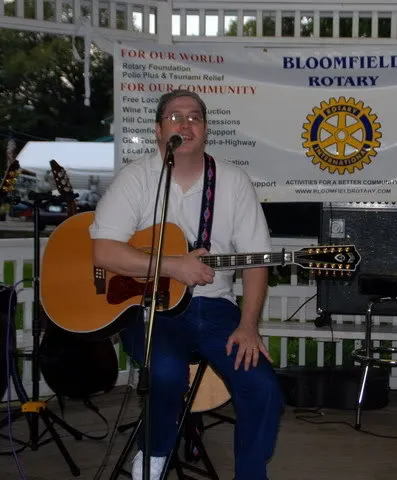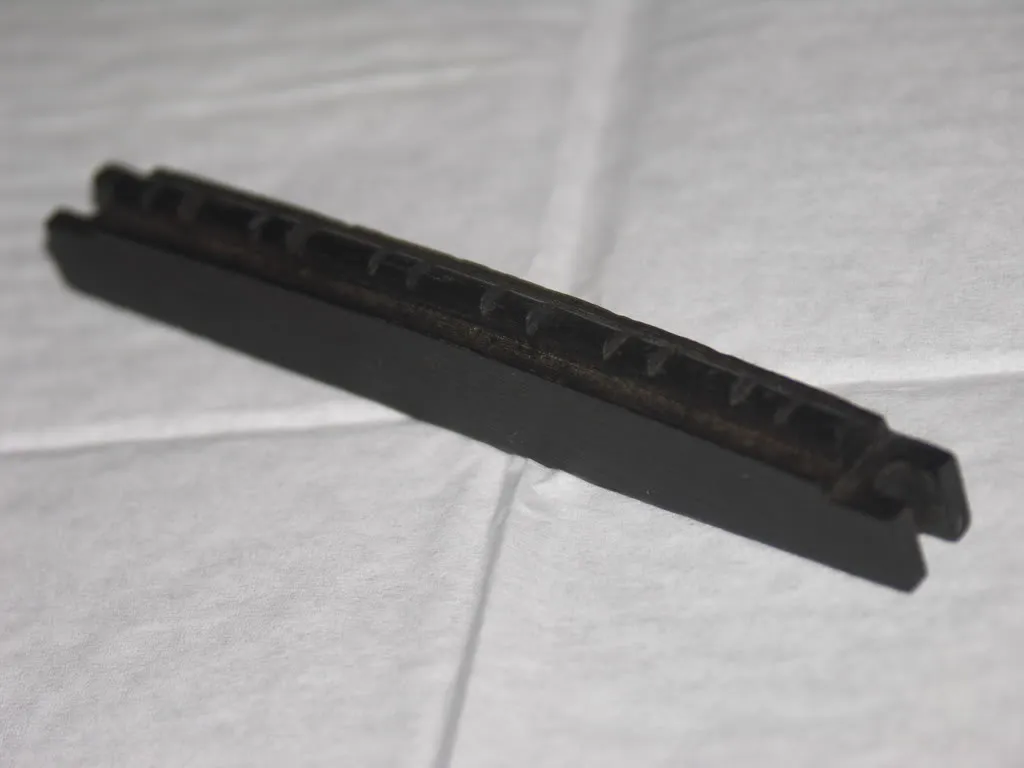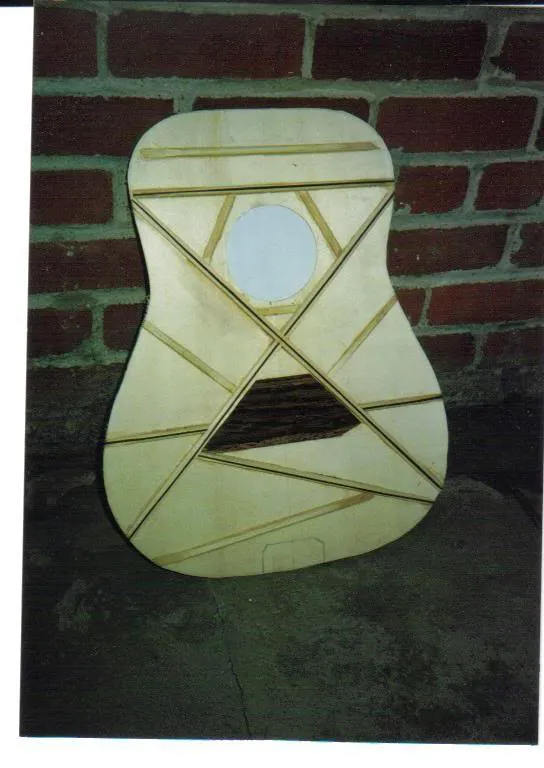Re: 12 string's 12strings
Chazmo,
First of all, I find myself in admiration of your description of the various forces at work on a pin bridge. I simply never thought of it like that
(as in, 'Really the whole thing wants to twist'). Thank you.
Candidly, I don't think I know enough about the science or mechanics of sound transmission in an acoustic guitar to comment on the difference or lack of difference between pin bridges and trapeze bridges. Having said that, there are some things I have noticed over the years that may affect your stated opinion that, 'it's at the saddle itself and forward along the vibrating string that matters.' I would like to share my thoughts with you and get your opinion on same (it's either that, or, 'Fools jump in'..).
There is certainly less of a break-over angle with a 'trapeze on a flat top' compared to a 'pin bridge on a flat top'. Trapeze/flat tops have a very shallow angle of tension compared to a pin bridge, maybe 10 to 20 degrees compared to 45 to 60 degrees on a pin bridge flat top (all these supposed angles are really my 'best guesses').
I believe that the difference in angle (pitch?) is very important to the sound of an instrument, whether it's at the bridge or the nut. Think of the differences between the way a 17 degree headstock pitch sounds on an old Gibson compared to the 14 degree pitch they used from '65 to.... sometime in the '80's (?). A 17 degree headstock will have more resonance than a 14 degree 'stock, all things being equal.
If you have any experience with Fender and Gibson electrics, you can get a feel for the difference that the 'various break-over angles of strings behind the bridge' can make:
Telecasters have a very sharp string angle behind the bridge, maybe 45 degrees. It really makes the strings pop. However, around '58 or '59, Fender changed the placement of the strings on this model. Instead of running the strings through the body directly beneath the bridge ('string through body' construction), they were channeled through the metal lip at the back of the bridge (for a year or so). Those Teles are called 'top loaders', because the strings 'load in' through the top instead of through holes in the bottom side of the body. 'Top loaders' have a markedly different break-over angle, perhaps as shallow as 20 or 25 degrees. They have a rather different sound from the 'true classic' Tele bridge-angle design; most tele lovers would describe them as 'weak and sloppy' in comparison to the 'real' Tele design.
With Gibson electrics, a great example of the same phenomenon can be found with the Les Paul Stop Tailpiece. The height of the Tailpiece itself is adjustable, so the angle of the strings in relation to the bridge can be changed from 0 degrees (bad idea) to 40-45 degrees. What I have noticed is that, at the shallower angles the guitar might sound better for light strumming, but at the most acute angles, the single notes sound brighter and crisper.
A few other things:
1) The basic thing to remember about trapeze-type tailpieces on a flat-top is that the break-over angle is almost always very shallow, because of the design of the neck/body relationship. This shallow angle tends to bring out the absolute worst features of the trapeze arrangement. Why? Well, I think it's because less string tension equates to less ability for the string to vibrate with a lot of snap and force.
2) A lot of Bigsby equipped guitars are designed to have a very shallow break-over angle, so that the bridge will not have much downward pressure on it and the strings will be more likely to return to the correct pitch after the Bigsby effect is used. Well, with time, the necks on all guitars can pull into the body. When that happens on a Bigsby-equipped guitar with a shallow neck angle, all the geometry goes way out of whack and the guitars almost cease to work, unless the neck is reset, or a different tailpiece is substituted to allow for a sharper break-over angle.
3) String length between bridge and tailpiece can make a difference, though I don't know much about that. You can test it out on an old Epiphone Arch-top equipped with a Frequensator tailpiece (used from 1938 on with most arch-top models); two separate tailpieces of rather different lengths both holding 3 strings, 'hooked' onto the same base plate. These tailpieces come off and you can swap them back and forth. When you switch between the short and the long tailpieces on the bass side strings, you can hear a bit of a difference, but it's been so long I can't remember what the heck it is....
As for how much the metal vibrates on a trapeze when strumming the guitar, well, I guess it depends on the angle/energy equation, the type of metal tailpiece, how much mass it has, etc.
Finally, getting back to the original deal (sort of), I wonder if the bracing is any different in the Gibson model 12s that use a pin-bridge and the ones that have a trapeze. Chazmo, I will bet you a soft drink that Gibson didn't change the bracing, which is why I am anxious to hear what someone like our friend '12 string' might have to say on the subject, when he gets around to it.
Whew, I think I'll stop typing!
Chazmo said:Gilded,
I was thinking about your post, and that's an interesting point about the bracing. I'd say you're probably right. You could probably have much more flexibility in the bracing pattern reinforcing a trapeze's saddle than a pin bridge/saddle. That said, while the back of a pin bridge needs to be anchored from pulling up, the front of the bridge (toward the soundhole) is pushing down. Really the whole thing wants to twist. With a trapeze, the only pressure on the saddle is down.
I'm guessing on this, but in terms of sound transmission, though, there's probably little difference between the two. What goes on behind the saddle (i.e., how the strings are anchored) is presumably not very significant in producing resonance in the body of the guitar. It's at the saddle itself and forward along the vibrating string that matters.
I'm not too sure about that though. I've never played a trapeze. Does the metal vibrate when strumming the guitar (I'm guessing not very much)?
Chazmo,
First of all, I find myself in admiration of your description of the various forces at work on a pin bridge. I simply never thought of it like that
(as in, 'Really the whole thing wants to twist'). Thank you.
Candidly, I don't think I know enough about the science or mechanics of sound transmission in an acoustic guitar to comment on the difference or lack of difference between pin bridges and trapeze bridges. Having said that, there are some things I have noticed over the years that may affect your stated opinion that, 'it's at the saddle itself and forward along the vibrating string that matters.' I would like to share my thoughts with you and get your opinion on same (it's either that, or, 'Fools jump in'..).
There is certainly less of a break-over angle with a 'trapeze on a flat top' compared to a 'pin bridge on a flat top'. Trapeze/flat tops have a very shallow angle of tension compared to a pin bridge, maybe 10 to 20 degrees compared to 45 to 60 degrees on a pin bridge flat top (all these supposed angles are really my 'best guesses').
I believe that the difference in angle (pitch?) is very important to the sound of an instrument, whether it's at the bridge or the nut. Think of the differences between the way a 17 degree headstock pitch sounds on an old Gibson compared to the 14 degree pitch they used from '65 to.... sometime in the '80's (?). A 17 degree headstock will have more resonance than a 14 degree 'stock, all things being equal.
If you have any experience with Fender and Gibson electrics, you can get a feel for the difference that the 'various break-over angles of strings behind the bridge' can make:
Telecasters have a very sharp string angle behind the bridge, maybe 45 degrees. It really makes the strings pop. However, around '58 or '59, Fender changed the placement of the strings on this model. Instead of running the strings through the body directly beneath the bridge ('string through body' construction), they were channeled through the metal lip at the back of the bridge (for a year or so). Those Teles are called 'top loaders', because the strings 'load in' through the top instead of through holes in the bottom side of the body. 'Top loaders' have a markedly different break-over angle, perhaps as shallow as 20 or 25 degrees. They have a rather different sound from the 'true classic' Tele bridge-angle design; most tele lovers would describe them as 'weak and sloppy' in comparison to the 'real' Tele design.
With Gibson electrics, a great example of the same phenomenon can be found with the Les Paul Stop Tailpiece. The height of the Tailpiece itself is adjustable, so the angle of the strings in relation to the bridge can be changed from 0 degrees (bad idea) to 40-45 degrees. What I have noticed is that, at the shallower angles the guitar might sound better for light strumming, but at the most acute angles, the single notes sound brighter and crisper.
A few other things:
1) The basic thing to remember about trapeze-type tailpieces on a flat-top is that the break-over angle is almost always very shallow, because of the design of the neck/body relationship. This shallow angle tends to bring out the absolute worst features of the trapeze arrangement. Why? Well, I think it's because less string tension equates to less ability for the string to vibrate with a lot of snap and force.
2) A lot of Bigsby equipped guitars are designed to have a very shallow break-over angle, so that the bridge will not have much downward pressure on it and the strings will be more likely to return to the correct pitch after the Bigsby effect is used. Well, with time, the necks on all guitars can pull into the body. When that happens on a Bigsby-equipped guitar with a shallow neck angle, all the geometry goes way out of whack and the guitars almost cease to work, unless the neck is reset, or a different tailpiece is substituted to allow for a sharper break-over angle.
3) String length between bridge and tailpiece can make a difference, though I don't know much about that. You can test it out on an old Epiphone Arch-top equipped with a Frequensator tailpiece (used from 1938 on with most arch-top models); two separate tailpieces of rather different lengths both holding 3 strings, 'hooked' onto the same base plate. These tailpieces come off and you can swap them back and forth. When you switch between the short and the long tailpieces on the bass side strings, you can hear a bit of a difference, but it's been so long I can't remember what the heck it is....
As for how much the metal vibrates on a trapeze when strumming the guitar, well, I guess it depends on the angle/energy equation, the type of metal tailpiece, how much mass it has, etc.
Finally, getting back to the original deal (sort of), I wonder if the bracing is any different in the Gibson model 12s that use a pin-bridge and the ones that have a trapeze. Chazmo, I will bet you a soft drink that Gibson didn't change the bracing, which is why I am anxious to hear what someone like our friend '12 string' might have to say on the subject, when he gets around to it.
Whew, I think I'll stop typing!





